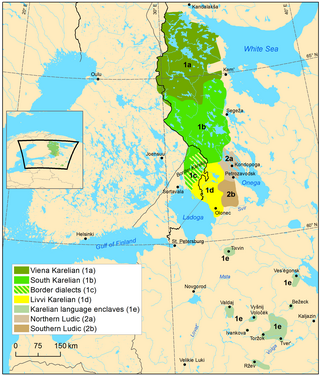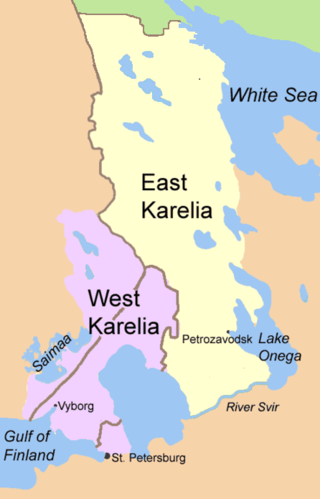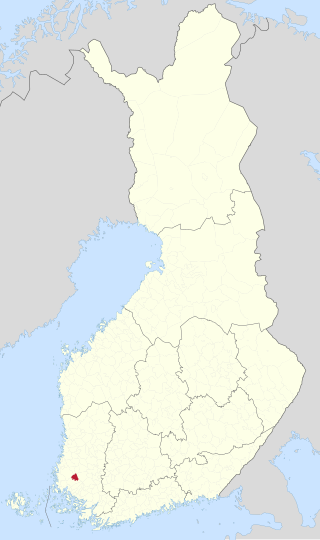
The Republic of Karelia, Karjala or Karelia, is a republic of Russia situated in the northwest of the country. The republic is a part of the Northwestern Federal District, and covers an area of 172,400 square kilometres, with a population of 533,121 residents. Its capital is Petrozavodsk.

Karelian is a Finnic language spoken mainly in the Russian Republic of Karelia. Linguistically, Karelian is closely related to the Finnish dialects spoken in eastern Finland, and some Finnish linguists have even classified Karelian as a dialect of Finnish, though in the modern day it is widely considered a separate language. Karelian is not to be confused with the Southeastern dialects of Finnish, sometimes referred to as karjalaismurteet in Finland. In the Russian 2020–2021 census, around 9,000 people spoke Karelian natively, but around 14,000 said to be able to speak the language.

Karelians are a Finnic ethnic group who are indigenous to the historical region of Karelia, which is today split between Finland and Russia. Karelians living in Russian Karelia are considered a distinct ethnic group closely related to Finnish Karelians, who are considered a subset of Finns. This distinction historically arose from Karelia having been fought over and eventually split between Sweden and Novgorod, resulting in Karelians being under different cultural spheres.

East Karelia, also rendered as Eastern Karelia or Russian Karelia, is a name for the part of Karelia that since the Treaty of Stolbovo in 1617 has remained Eastern Orthodox and a part of Russia. It is separate from the western part of Karelia, called Finnish Karelia or historically Swedish Karelia. Most of East Karelia has become part of the Republic of Karelia within the Russian Federation. It consists mainly of the old historical regions of Viena Karjala and Aunus Karjala.

Karelia is an area in Northern Europe of historical significance for Russia, Finland, and Sweden. It is currently divided between northwestern Russia and Finland.

Olonets Karelia is a historical and cultural region and the southern portion of East Karelia, which is apart of Russia. Olonets Karelia is located between the other historical regions of Ladoga Karelia, to its west, White Karelia, to its north, the River Svir, to its south and Lake Onega on its eastern side. Olonets Karelia is home to its own dialect of the Karelian language, which is known as Livvi Karelian or sometimes as 'Olonets Karelian'.

The Karelian question or Karelian issue is a dispute in Finnish politics over whether to try to regain control over eastern Karelia and other territories ceded to the Soviet Union in the Winter War and the Continuation War. Despite the name "Karelian question", the term may refer also to the return of Petsamo, ceded parts of Salla and Kuusamo, and four islands in the Gulf of Finland. Sometimes the phrase "debate on the return of the ceded territories" is used. The Karelian question remains a matter of public debate rather than a political issue.

Greater Finland, was an irredentist and nationalist idea that was a subset of Pan-Finnicism which emphasized the territorial expansion of Finland. The most common concept of Greater Finland saw the country as defined by natural borders encompassing the territories inhabited by Finns and Karelians, ranging from the White Sea to Lake Onega and along the Svir River and Neva River—or, more modestly, the Sestra River—to the Gulf of Finland. Some proponents also included the Torne Valley, Ingria, and Estonia.
Karjalan Liitto is a Finnish organisation that promotes Karelian culture and history. It also functions as an interest group for Karelian evacuees. As of 2023, the organization consists of 14 districts in Finland, cooperating with other Karelian movements and organisations.

The Karelian Autonomous Soviet Socialist Republic, Karelian ASSR for short, sometimes referred to as Soviet Karelia or simply Karelia, was an autonomous republic of the Russian SFSR, Soviet Union, with the capital in Petrozavodsk.

Ladoga Karelia is a historical region of Karelia, currently largely in Russia. Today, the term refers to the part of the Republic of Karelia in the Russian Federation comprising the south-west part of the Republic, specifically Lakhdenpokhsky District, Pitkyarantsky District and Sortavala District. This region is on the northern littoral of Lake Ladoga, which borders Olonets Karelia to the East, Leningrad Oblast to the south-west and the North Karelia region of Finland to the west.

The Karelian people's presence can be dated back to the 7th millennium BC–6th millennium BC. The region itself is rich with fish, lakes, and minerals, and because of that throughout history changed its holder, to this day divided between the Republic of Finland and the Russian Republic.

The East Karelian Uprising and the Soviet–Finnish conflict 1921–1922 were an attempt by a group of East Karelian separatists to gain independence from the Russian Soviet Federative Socialist Republic. They were aided by a number of Finnish volunteers, starting from 6 November 1921. The conflict ended on 21 March 1922 with the Agreements between the governments of Soviet Russia and Finland about the measures of maintenance of the inviolability of the Soviet–Finnish border. The conflict is regarded in Finland as one of the heimosodat – "Kinship Wars".
Lyudmila Fyodorovna Markianova is a Karelian linguist and a professor emerita. She has been called "karjalan kielen muamo", i.e. 'mother of the Karelian language'.

The Karelian United Government was a short-lived state that existed from 1920 to 1923, as a merger of the Republic of Uhtua and the Olonets Government of Southern Karelia.

Oma Mua is a Karelian-language newspaper published in Petrozavodsk, Republic of Karelia. The newspaper is owned by OmaMedia, and was merged together with Vienan Karjala in 2014.
The Juminkeko Foundation, or simply Juminkeko, is a Finnish organization founded in 1991. It runs Juminkeko, an eponymous information centre of the national epic Kalevala and Karelian culture located in Kuhmo, Finland. The centre was designed by the Finnish architects Mikko Heikkinen and Markku Komonen and was completed in 1999.

Karjala is a former municipality of Finland in the former Turku and Pori Province, now in Finland Proper. It was consolidated with Mynämäki in 1977.

The Karelian National Movement, officially KKL-Stop the Occupation of Karelia is an umbrella term for two organizations that split from each other in 2023. The organization led by the original creator, Dmitry Kuznetsov, who also goes by the name Miteri Panfilov, is called Stop the Occupation of Karelia, it was previously known as the Karelian National Liberation Movement. The organization led by Vladislav Oleynik is called the Karelian National Movement.

Union of Karelian People or Regional Public Organization "Union of Karelian People" or RPO "UKP" is a regional Karelian public organization dedicated to the preservation and development of the Karelian culture and the Karelian language. It carries out its activities in the Republic of Karelia and other regions of the Russian Federation, Finland and other Karelian communities. It is one of the biggest and oldest Karelian culture organizations in Russia.















